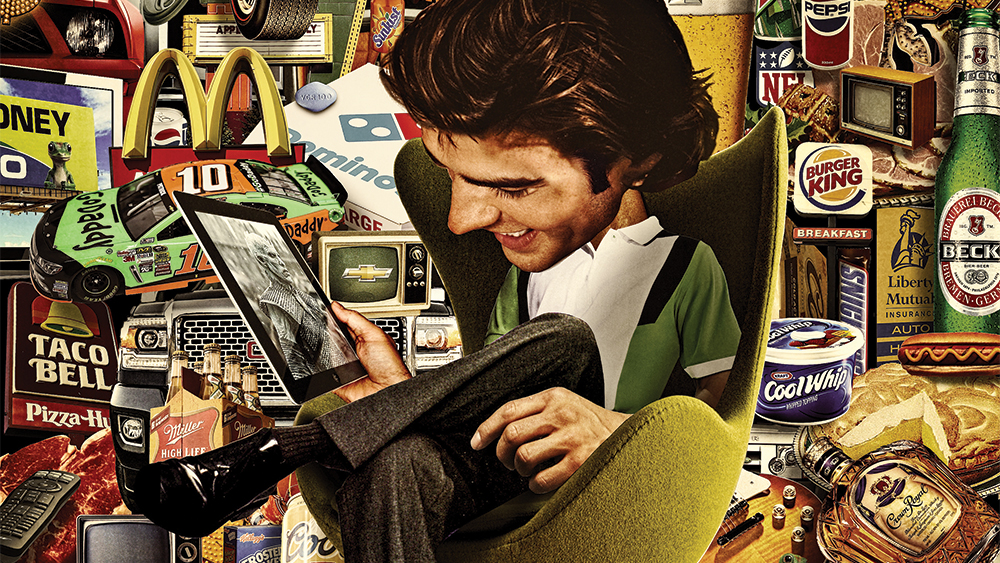Death of the Commercial Break: Why Marketers Need to Get More Creative Than Ever
By Brian Steinberg
LOS ANGELES (Variety.com) – Television has for decades pumped out a never-ending supply of glitzy commercials. Viewers liked some of them and tolerated the rest. Now their patience is wearing perilously thin.
With more people tuning in to streaming venues like Netflix and Amazon, where programs run ad free, TV networks are under pressure to figure out ways to make commercial breaks less of a chore to sit through and more a part of the overall experience. The shift is pushing advertisers and TV executives to make radical revamps to a cornerstone of the viewing experience and a fundamental source of profits: the commercial break.
That no-longer-so-brief interruption has been a staple of the home screen since the Bulova Watch Co. managed to get a 10-second video of one of its timepieces placed in a baseball game between the Philadelphia Phillies and the Brooklyn Dodgers on what is now New York’s WNBC in 1941. After that moment, recognized as TV’s first commercial break, everyone wanted one — and got that and more.
In 2018, the time has come to work with less. 21st Century Fox’s FX, for example, runs just two minutes of advertising per hour in its digital streams. AMC last year launched an ad-free subscription service available via Comcast. “You have more and more competition for consumer attention with ad-free experiences, and that leaves a lot of our consumers to expect and really seek out lighter ad loads and less interruptions,” says David Levy, executive vice president of non-linear revenue at Fox Networks Group. “We have to respond in a smart way.”
Billions of dollars are at stake. Spending on national TV advertising is projected to grow just 0.2% to nearly $43.5 billion in 2018, according to media research firm Magna. To keep the money flowing, the networks are more willing than ever to blend commercials with TV content. And they have tapped a range of technologies that allow advertisers to place commercials with greater finesse — in just the right programs and time slots to reach, say, a first-time car buyer, an expectant mother or even someone who is more likely to go to a movie opening. They are doing all this as Magna projects ad spending will surge on newer venues such as mobile (28.5%) or social (31.4%).
The dynamics force TV networks into a balancing act, as Madison Avenue presses hard for original ideas. “What they are saying is ‘What can we do that’s never been done before?’” says Jo Ann Ross, president and chief advertising revenue officer at CBS Corp. “We are trying to crack the code,” she says, on how to offer concepts that help advertisers stand apart while still generating the revenue media companies need to flourish. Already, CBS is moving forward with a plan that will let advertisers add tailored messages to national commercials seen by viewers using certain connected TVs. A retailer with a sale at an outlet 30 miles away could add a note to someone who lives close by, and a restaurant might tout its delivery service in a particular city or town.
Even one of the biggest producers of traditional TV ads sees a need for networks to cut some of their commercial weight. McCann Worldgroup has had a hand in everything from Coca-Cola’s seminal 1971 effort — crammed with young people on a hilltop singing, “I’d like to buy the world a Coke”— to a recent spot for Cigna that gathers famous TV doctors from across the decades.
Now the CEO of the advertising giant believes TV should change its approach. “The networks forgot that, as they expanded time for commercials, they fundamentally disconnected from viewers who were there to see a television show,” says Harris Diamond, chairman and CEO of McCann, a unit of Interpublic Group. Madison Avenue likes ads because they are adjacent to the shows consumers love, he says. But due to dozens of spots airing each hour in sitcoms and dramas, that TV perch has become “an adjacency to advertising, and an adjacency to advertising is not what we are generally looking for.”
Some advertisers have grown wary of the environment in which their commercials play. “There is literally an overload to consumers, where they are hit by approximately 5,000 messages every single day,” says Raja Rajamannar, chief marketing and communications officer of MasterCard, “and they have learned to tune out those ads.”
| Procter & Gamble teamed up with the ABC comedy to embed an ad pitch into an episode’s plotline. Courtesy of |
TV’s newest commercials will tie themselves more closely to the show viewers have decided to watch or the moment at which they are staring at the screen. And they will replace hundreds of pitches that have for decades relied on harried housewives, doofy dads, Trix rabbits and Geico geckos to make a sale. Taco Bell’s most recent memorable campaign looks less like a commercial and more like a movie trailer, which, as any TV ad-sales executive can tell you, typically sparks more attention than a standard ad.
“What’s going to fundamentally stick and be a part of the new model? It remains to be seen,” says Sasha Wolfe, head of media at Taco Bell. “Everyone is still exploring.”
The result: Networks are blazing radical new paths. Both NBCUniversal and 21st Century Fox this season are trying to shake up the way commercials are presented. Fox Broadcasting expects to offer shortened commercial “pods” during the entire season of “The Orville” as well as throughout the primetime schedule on three Sundays in the fall, says Fox’s Levy.
NBCUniversal has pledged to cut fourth-quarter primetime ad inventory by 10% during original airings of approximately 50 programs across its portfolio of networks. Viewers are not likely to see a commercial until 20 minutes into an hour-long drama, says Mark Marshall, executive vice president of entertainment advertising sales at NBCU. Ads in half-hour comedies probably won’t manifest until eight minutes in, he says. The first break will be known as a “prime pod” and is likely to feature advertising that plays off the program or contains a timely element. NBCU made the move, he says, because “the length of commercial pods obviously matters to the consumer and we want to continue to respect their time and interest.”
Other networks have shown interest in stitching commercial messages more deeply into their programs. Procter & Gamble was able to place a cause-related message into an episode of ABC’s “Black-ish,” aligning a commercial pitch with a plotline in the script and dialogue spoken by the show’s characters. The network is open to doing more, says Jerry Daniello, senior vice president of integrated marketing, and puts emphasis on creating specific ideas depending on advertisers’ needs and the demands of a particular show.
These concepts can be challenging because they often require weeks if not months of advance work: knowledge of plotlines, the cooperation of the writers room or the right overlap of TV-show story and advertising goals. ESPN has an offer that is akin to real-time product placement. Producers at the sports-media outlet have their hands on constantly changing brews of statistics about players and teams, notes Ed Erhardt, ESPN’s president of global sales and marketing, “and we can literally tweak those in real time as we find out what’s going on and use them with ad messages from someone who is buying a college football game.”
“What they are saying is ‘What can we do that’s never been done before?’ We are trying to crack the code.”
Jo Ann Ross, CBS president and chief advertising revenue officer
Even bigger changes in TV advertising are in the works behind the scenes. The average viewer will never see WarnerMedia or Viacom executives culling audience data from a bevy of sources and then sharing it with an advertiser to determine the best placement for specific commercials. Nor will they see CBS or “split” ad space during an airing of “Young Sheldon” or “The Walking Dead” so different viewers of the show see different ad spots. But that doesn’t mean those things aren’t happening.
These moves amount to a reversal of the TV model. For decades, Madison Avenue followed a “pay and spray” strategy. An advertiser put the same commercial in every program, on every network, no matter the time of day. Where it appeared often didn’t matter that much, because viewers had fewer choices, and big, broad audiences were in abundant supply. Now that TV crowds have splintered around dozens of viewing opportunities and behaviors, marketers want to drill down more deeply on places they think they can find their most likely customers.
The hope is these new methods will generate greater ad revenue. “We believe that our clients will need our help making more content with them, and we believe they will need our help in identifying who the right audiences are for that content,” says Dan Riess, executive vice president of content partnerships and co-head of Turner Ignite, part of WarnerMedia’s Turner. Meanwhile, Viacom recently licensed its Vantage ad-data technology to 21st Century Fox and hopes to do more with others, says Bryson Gordon, who oversees Viacom’s advanced advertising work.
In the fourth quarter, CBS intends to help sponsors get even more granular. The company has struck a pact with Nielsen that allows an advertiser to send different commercials to different households. Rather than beaming the same ad to every viewer in the nation, CBS can “split” the spot — sending an ad for a lower-priced car to a household owned by a young couple, or an ad for high-end technology to a TV watched by high-income consumers.
Not too long ago, viewers understood that a commercial break was a necessary interruption. The advertising allowed them to see their favorite shows for free. In an era when people are paying for multiple video subscriptions, Madison Avenue needs to re-emphasize the connection, says Claudia Cahill, who oversees content alliances between advertisers and media outlets for Omnicom Media Group.
“There’s an opportunity to create an experience around a show that enhances the viewing for the consumer,” she says. “It’s not going to be an easy thing to do,” she adds, but “more of that is going to happen.”
The TV networks can’t afford not to try.


